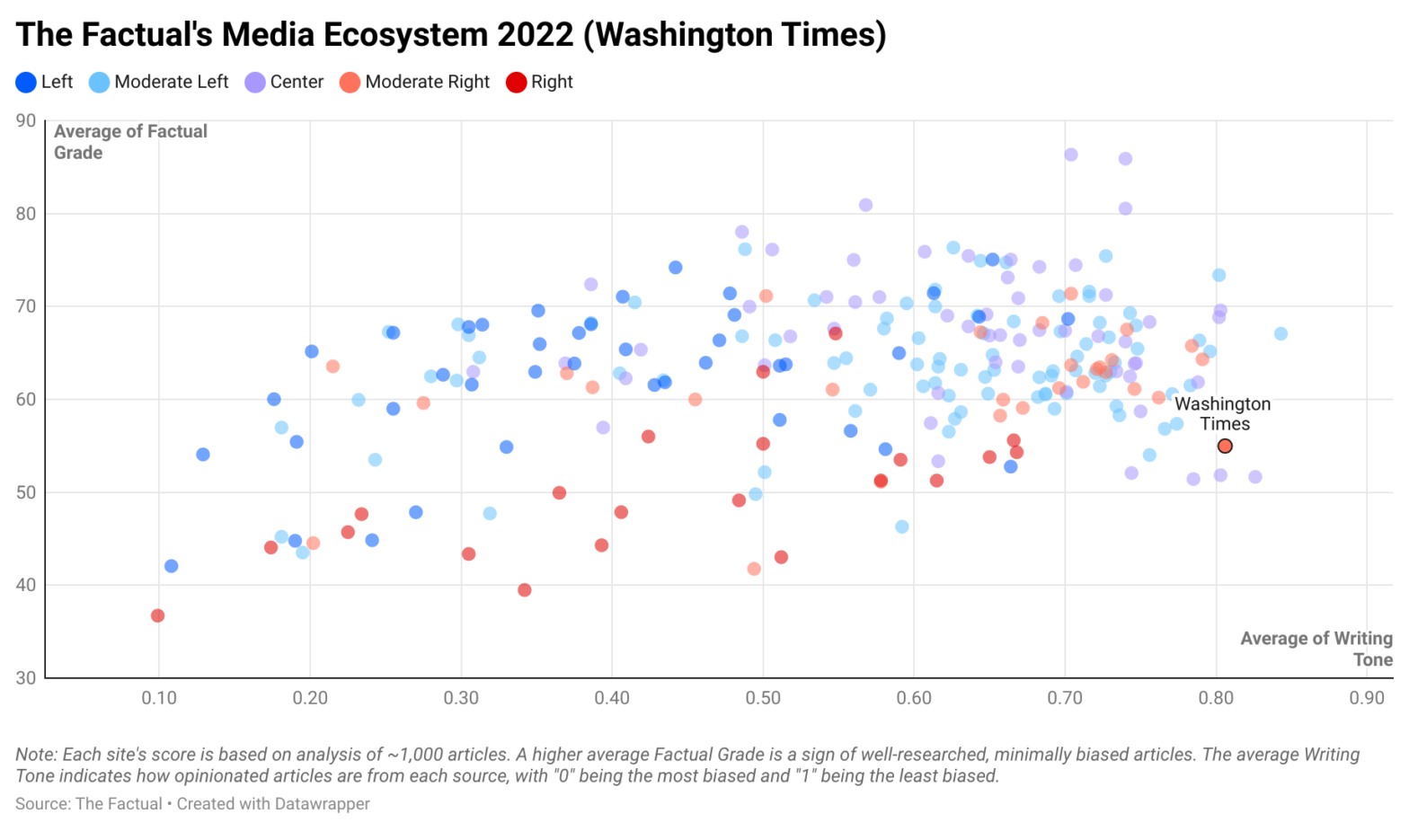Originally conceived of as a conservative alternative to the Washington Post, the Washington Times has a checkered past. The paper’s founder was the head of the Church of Unification, what many deem to be a religious cult, but the paper found a sustained audience in Washington, including former president Ronald Reagan, who claimed to have read the paper daily while in office. Today, the paper is recognized for solid reporting on daily news stories but has repeatedly been caught spreading false claims and conspiracy theories. So how reliable of a news source is the Washington Times?
How Does The Factual Rate News Sources?
The Factual analyzes more than 10,000 news stories every day to help readers find the most informative, least-biased articles. Our news-rating algorithm scores each article along four metrics: (1) cited sources and quotes, (2) publication history, (3) writing tone, and (4) author expertise. These scores combine in a weighted average we call a Factual Grade, which ranges from 0–100%. (See our How It Works page to learn more about our algorithm.)
For this study, we analyzed ~1,000 articles each from 240 news sources. The average Factual Grade for the entire dataset was 62.5%. Based on these averages, we can compare the performance of news sites across the media ecosystem. The entire dataset can be explored in greater detail here.
How Factual Is the Washington Times?
The Washington Times scored an average Factual Grade of 55.0%, placing it in the 17th percentile of our dataset. Poor sourcing of information and limited inclusion of external evidence drive these low scores for Washington Times news articles. For example, stories either incorporate no external links, contain very few links, or only link to other Washington Times content. This means articles may fail to incorporate external evidence or outside reporting on a topic. That said, the site does deliver many day-to-day news with low bias and largely factual reporting.
Like any news source, scores from the Washington Times varied widely based on factors like author expertise and cited evidence. For example, some scored above 70%, while others scored below 50%.
Please check your email for instructions to ensure that the newsletter arrives in your inbox tomorrow.
How Opinionated Is the Washington Times?
The Factual measures how opinionated an article is using a sophisticated natural language processing algorithm, producing a score we call the Writing Tone. For this metric, the algorithm looks for signs of subjective commentary (e.g., first person pronouns, unnecessary adverbs), as well as the emotional nature of selected words, and sees how prevalent they are for a given length of text. Text which is less opinionated gets higher ratings, with “0” being the most opinionated and “1” being the most neutral.
The Washington Times had an average Writing Tone score of 0.80, placing it in the 98th percentile in our dataset for this metric, the fourth-highest score that we measured. This suggests many articles from the site use highly neutral wording, as seen in headlines such as “Biden administration abolishes ICE labor union” and “California expected to ban sale of gas-powered cars by 2035.”
What Is the Political Bias of the Washington Times?
The Factual classifies news sites by political bias as either Left, Moderate Left, Center, Moderate Right, or Right. This classification comes from third-party assessments from media bias organizations such as AllSides and Media Bias/Fact Check (MBFC). Based on this data, The Factual assigns the Washington Times a Moderate Right bias.
AllSides classifies the Washington Times as “Lean Right” based on an independent survey, a blind-bias survey, and 42,264 community ratings. They find this classification to be relatively uncontroversial since the site specifically targets center-right conservatives and defines itself as a conservative news outlet. A “vast majority” of the AllSides community ratings also agree with this assessment.
MBFC positions the Washington Times as “Right-Center” but also as a “Questionable” source. According to MBFC, the site has an “extreme right editorial bias” but reports straight news with less bias. The “Questionable” rating is due to the site’s tendency for “poor sourcing, holding editorial positions contrary to scientific consensus,” and numerous failed fact checks. Such factual errors include stories such as “Facial recognition firm claims antifa infiltrated Trump protesters who stormed Capitol,” which has since been corrected. They also publish climate change conspiracy theories, including that “global warming and then the climate change narrative was cooked up by America’s adversaries to enable our enemies to eventually dominate us.”
Who Owns the Washington Times?
Sun Myung Moon, a Korean religious leader and businessman, founded the Washington Times in 1982. He also founded and led the Unification movement — a religious movement of which Moon and his wife were central, messianic figures. Today, the Washington Times belongs to Operations Holdings, which remains associated with the Unification movement. Moon pictured the paper as a conservative alternative to the Washington Post. Over time, it has been accused of having a pro-Christian bias and of being the mouthpiece of the Unification Church.
Please check your email for instructions to ensure that the newsletter arrives in your inbox tomorrow.
Why Does It Matter?
News articles always have some bias because all authors have some frame of reference within which they describe a story. Political bias ratings are helpful in understanding this framing. However, it can be more beneficial to know how factual an article is based on quantifiable metrics that can be seen across the media ecosystem, such as cited evidence, author expertise, and writing tone. This is what The Factual ascertains.
Reading several, highly rated articles from across the political spectrum helps counter the bias of any news source or story. To have the day’s most factual news stories delivered to your inbox every morning, subscribe to our daily newsletter.
Article updated on September 22, 2022 to reflect new data.

